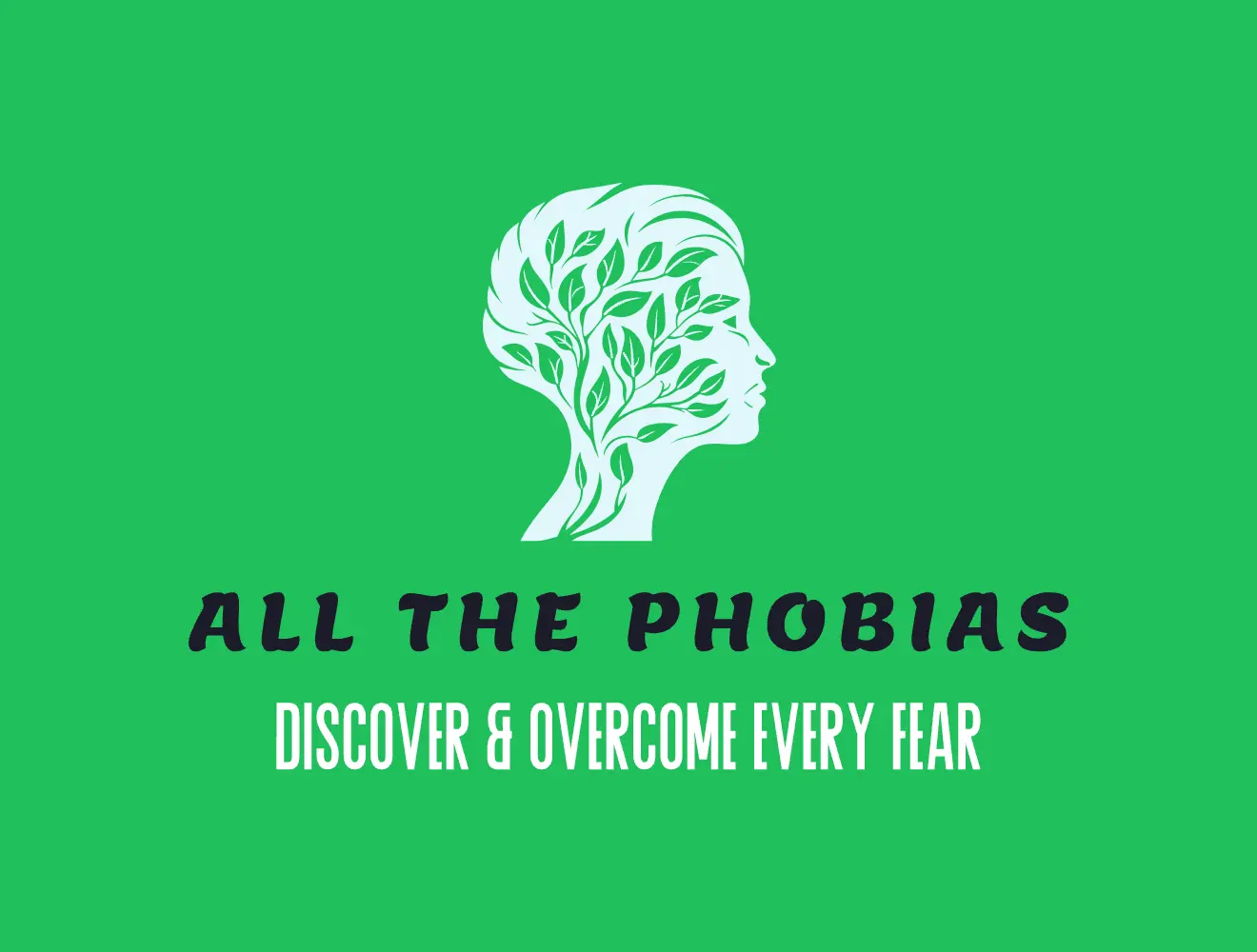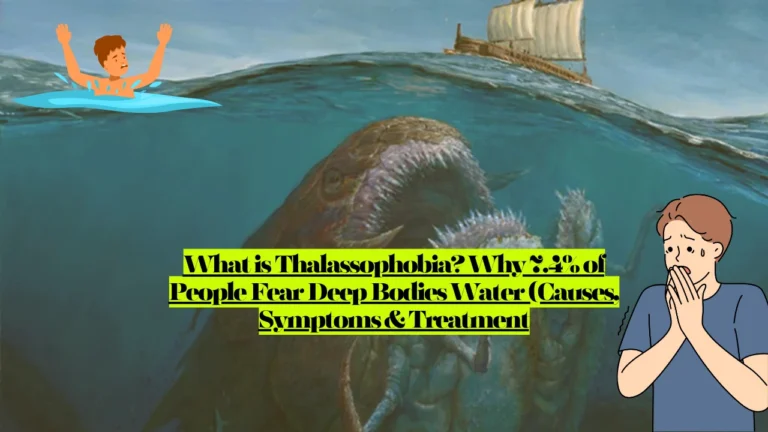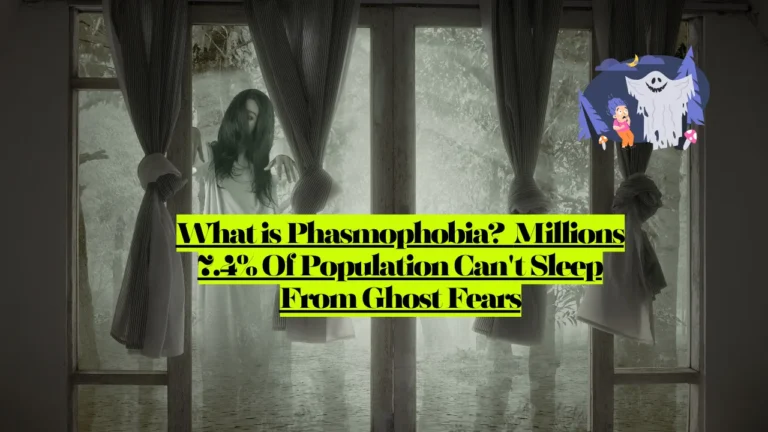Globophobia is the persistent, irrational fear of balloons that causes significant distress and interferes with daily functioning. If you experience intense anxiety, panic attacks, or go to great lengths to avoid balloons, you may be dealing with this specific phobia that affects more people than you might think.
What exactly is Globophobia?
Globophobia comes from the Latin word “Globus” (meaning sphere) and the Greek word “Phobos” (meaning fear). People with globophobia experience overwhelming terror when encountering balloons in any form – whether seeing them, hearing them pop, or even thinking about them.
This isn’t simply being startled by a balloon popping. Globophobia is a legitimate anxiety disorder where the fear response is completely disproportionate to any actual threat balloons pose.
Here’s what you need to know immediately:
- Globophobia affects approximately 2-3% of people with specific phobias, making it more common than many realize
- It’s classified under specific phobias in the DSM-5, making it a recognized mental health condition
- Success rates for treatment range from 70-90% with proper therapeutic intervention
- Most cases develop in childhood but can persist into adulthood without treatment
- It’s closely connected to phonophobia (fear of loud sounds) since balloon popping is often the primary trigger
The reality about Globophobia: This phobia can severely limit your ability to attend celebrations, social gatherings, and even simple activities like grocery shopping where promotional balloons might be present.
At AllThePhobias.com, we’ve researched the latest clinical findings and therapeutic approaches to help you understand and overcome Globophobia. Let’s explore what this fear really involves and your path to recovery.
Do You Have Globophobia? Key Signs to Look For
Generally, people with globophobia will refuse to touch, feel, smell, or go near a balloon for fear it will burst. Here are the key signs that indicate you may be experiencing this specific phobia:
Physical Symptoms When Encountering Balloons:
- Rapid heartbeat and increased heart rate
- Sweating and trembling
- Shortness of breath or difficulty breathing
- Nausea or stomach discomfort
- Dizziness or lightheadedness
- Muscle tension and restlessness
These symptoms align with typical anxiety responses and can range from mild discomfort to full panic attacks.
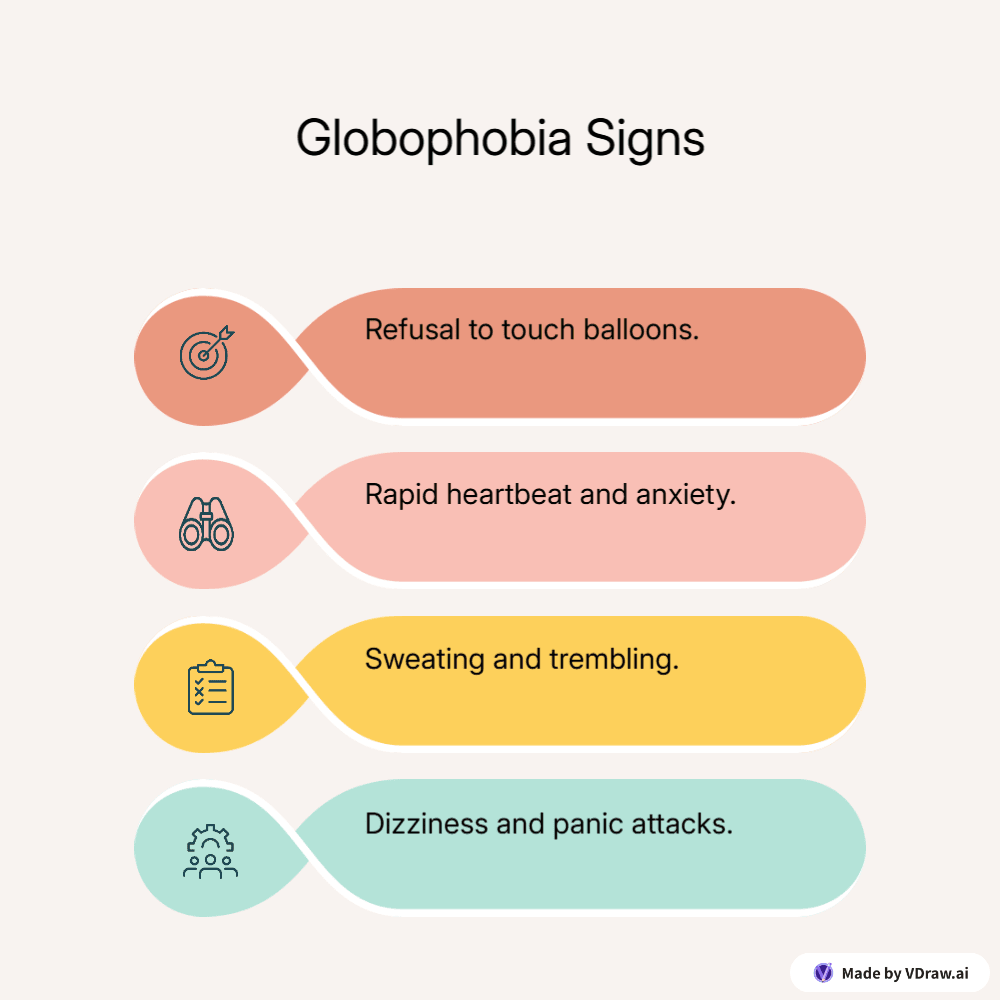
Emotional & Mental Responses:
- Overwhelming sense of dread when seeing balloons
- Intrusive thoughts about balloons popping
- Inability to concentrate in environments with balloons present
- Persistent worry about encountering balloons
- Feeling embarrassed or ashamed about the fear
The severity can range from mild uneasiness to panic-level terror that completely overwhelms your ability to function normally.
Behavioral Changes:
- Avoiding social events or gatherings where there might be balloons, struggling to go to parties or even restaurants where they may encounter balloons
- Refusing to attend children’s birthday parties or celebrations
- Checking venues beforehand to ensure no balloons are present
- Developing sophisticated safety behaviors and routines over time
- Asking others to remove balloons from your presence
When these responses significantly interfere with your daily life, relationships, or ability to participate in normal activities, it indicates clinical significance that warrants professional attention.
Related Phobia: What is Emetophobia? Fear of Vomiting Affecting 8.8% Learn symptoms, Causes, Triggers
Understanding Globophobia: The Complete Analysis
What Causes This Fear?
The Science Behind It: Globophobia can be the result of a negative or traumatic experience with balloons, negative depictions of balloons, or a traumatic event somehow connected to balloons. The fear often develops through classical conditioning, where the brain associates balloons with danger or trauma.
Neurological Response: When encountering balloons, your amygdala (your brain’s alarm system) triggers the fight-or-flight response, flooding your system with stress hormones like adrenaline and cortisol. This creates the intense physical and emotional reactions you experience.
Evolutionary and Phonophobic Connection: This is a form of phonophobia, and the phobia does often extend to anything else which makes the same noise as balloons bursting. Our brains are naturally programmed to fear sudden, loud noises as potential threats, making the popping sound particularly triggering.
Development Patterns:
Childhood Origins: These negative experiences usually occur during childhood, and globophobia is most prevalent among young children. Globophobia fear of balloons usually occurs when a child has had a balloon burst in their face. Common childhood triggers include:
- A balloon unexpectedly popping near the child’s face
- Being startled by multiple balloons bursting simultaneously
- Witnessing someone else’s distressed reaction to balloon popping
- Associating balloons with other traumatic events
Adult-Onset Presentations: While less common, adults can develop globophobia through:
- Sensory processing sensitivity that makes them more reactive to sudden sounds
- Anxiety disorders that amplify fear responses
- Secondary trauma from witnessing others’ severe reactions
Learned Responses: The fear can be learned through observation (watching others react fearfully to balloons) or through repeated exposure to negative balloon-related experiences.
Risk Factors:
Several factors can increase the likelihood of developing globophobia:
- Family history: Having relatives with anxiety disorders or specific phobias
- Personality traits: High sensitivity to noise, perfectionism, or general anxiety
- Co-occurring conditions: Other anxiety disorders, PTSD, or sensory processing issues
- Age: More common in children, though many grow out of the fear before adolescence
How It Differs From Normal Fear:
Normal fear of sudden loud noises is temporary and doesn’t significantly impact daily life. Globophobia becomes clinically significant when it involves a fear of balloons that interferes with day-to-day life. The key differences include:
- Duration: Lasting fear that doesn’t diminish over time
- Intensity: Disproportionate to the actual threat
- Interference: Significantly impacts social activities, celebrations, and daily routines
- Avoidance: Extensive efforts to avoid balloon-related situations
Comprehensive Triggers & Situations
All Major Globophobia Triggers:
Visual Triggers:
- Balloons of any size, color, or material
- Balloon decorations at parties or events
- Images or videos of balloons (including on screens)
- Balloon bouquets or arrangements
- Helium balloons floating at different heights

Auditory Triggers:
- The sound of balloons popping is the most common source of fear
- Balloon squeaking when rubbed or twisted
- The stretching sound when inflating balloons
- Even the sound of them squeaking or just the feeling of them is enough to prompt a reaction
Tactile Triggers:
- The texture and smell of balloons can trigger individuals
- The latex or rubber material feeling
- Static electricity from balloons
- The sensation of balloons touching skin or hair
Situational Triggers:
- Birthday parties and celebrations
- Weddings and special events
- Restaurants with balloon decorations
- Parades and festivals
- Retail stores with promotional balloons
- Hospital or medical settings using balloons for comfort
Modern Digital Triggers:
In today’s digital age, globophobia can extend to:
- Social media posts featuring balloons
- Online videos with balloon content
- Video games or virtual environments with balloons
- Streaming content with balloon scenes
- Advertising featuring balloon imagery
Workplace & Educational Settings:
- Office celebrations with balloon decorations
- School events and classroom decorations
- Conference venues with balloon displays
- Training facilities using balloons for activities
- Healthcare settings where balloons are used therapeutically
Myths vs. Facts About Globophobia
Understanding the truth about globophobia helps recognize when professional help is needed and avoids harmful misconceptions.
Myth #1: “It’s Just Being Scared of Loud Noises”
FACT: While globophobia often involves fear of popping sounds, many people fear balloons even when silent. The sight, smell, or texture can trigger intense anxiety – it’s specifically about balloons, not just loud noises.
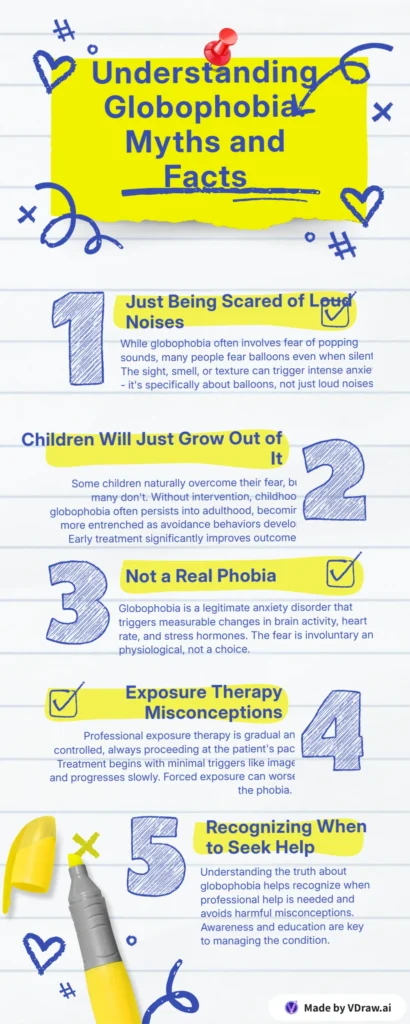
Myth #2: “Children Will Just Grow Out of It”
FACT: Some children naturally overcome their fear, but many don’t. Without intervention, childhood globophobia often persists into adulthood, becoming more entrenched as avoidance behaviors develop. Early treatment significantly improves outcomes.
Myth #3: “It’s Not a Real Phobia – People Are Being Dramatic”
FACT: Globophobia is a legitimate anxiety disorder that triggers measurable changes in brain activity, heart rate, and stress hormones. The fear is involuntary and physiological, not a choice.
Myth #4: “Exposure Therapy Means Forcing Someone to Face Balloons Immediately”
FACT: Professional exposure therapy is gradual and controlled, always proceeding at the patient’s pace. Treatment begins with minimal triggers like images and progresses slowly. Forced exposure can worsen the phobia.
Myth #5: “You Can Cure It By Popping Balloons Until You Get Used to It”
FACT: This “flooding” approach can be traumatic without professional guidance. It may intensify fear and create additional trauma. Successful treatment requires systematic desensitization under supervision.
Myth #6: “Adults Should Just Be Able to Overcome It Alone”
FACT: Phobias involve deep neurological patterns difficult to change without professional help. Seeking treatment is a sign of strength. Professional intervention provides tools that are hard to develop independently.
For Parents: Helping Your Child Cope with Globophobia
Your role is crucial in your child’s recovery. Here’s how to provide effective support.
Recognizing Globophobia in Children
Behavioral Signs:
- Refusing to attend parties where balloons might be present
- Crying or tantrums when seeing balloons
- Asking repeatedly if balloons will be at upcoming events
- Leaving rooms immediately when balloons appear
- Covering ears in anticipation of popping sounds
Physical Symptoms:
- Rapid breathing or hyperventilation
- Trembling or shaking
- Stomach aches or headaches near balloons
- Hiding behind parents
What Parents Should Do
Immediate Response When Child Encounters Balloons:
- Stay Calm and Reassuring
- Your calm demeanor signals safety to your child
- Say: “I see you’re feeling scared. You’re safe with me”
- Avoid showing frustration or dismissiveness
- Validate Their Feelings
- Never say “Don’t be silly” or “There’s nothing to fear”
- Instead: “I understand you’re frightened. That feeling is real, and I’m here to help”
- Use Child-Friendly Grounding Techniques
- For younger children: “Let’s count five red things we can see”
- For older children: “Breathe in like smelling flowers, out like blowing bubbles”
- Physical grounding: “Squeeze my hand three times”
Long-Term Support:
Create a “Fear Plan” Together:
- Develop step-by-step actions for when they see balloons
- Write it down with drawings
- Practice when calm
- Example: 1) Take three breaths, 2) Tell adult “I’m scared”, 3) Move to comfortable distance
Gradual Home Exposure (Never Forced):
- Start with cartoon balloon pictures
- Progress to photos at a distance
- Let your child control the pace
- Celebrate small victories
Communication:
- Inform teachers about the phobia
- Request advance notice of classroom parties
- Prepare for social events by contacting hosts
- Teach your child age-appropriate phrases to ask for help
What Parents Should NOT Do
Avoid These Harmful Approaches:
- Never Force Exposure – Don’t surprise them with balloons or hold them near balloons while panicking. This creates trauma and worsens the phobia.
- Don’t Minimize or Mock – Avoid “You’re too old for this” or “That’s silly.” Never allow teasing from siblings.
- Don’t Enable Complete Avoidance – While removing them from overwhelming situations is appropriate, work toward gradual exposure rather than eliminating all balloon encounters forever.
- Don’t Show Excessive Anxiety – Children mirror parental worry. Stay calm even if concerned.
- Never Punish Fear Reactions – Don’t remove privileges or guilt-trip them for fear-based behaviors.

When to Seek Professional Help
Clear indicators treatment is needed:
- Fear worsening over time
- Avoidance behaviors expanding
- Missing school events or social activities
- Fear persisting beyond age 6-7
- Physical symptoms are severe (panic attacks, vomiting)
- Family life significantly disrupted
Finding the Right Professional: Look for child psychologists specializing in anxiety disorders with experience in specific phobias. Ask about their treatment approach (CBT, exposure therapy) and success rates with children.
Treatment Success for Children:
- Ages 4-8: 80-95% success rate with early intervention
- Ages 8-12: 75-90% show significant improvement
- Average duration: 8-12 sessions
- Children often respond better than adults to phobia treatment
Real-World Impact & Life Challenges
Sarah, a graphic designer, found her globophobia significantly impacted her work when she couldn’t attend company celebrations or client events featuring balloon decorations. After seeking treatment through exposure therapy, she learned coping strategies that allowed her to manage her fear while maintaining her professional relationships.
Common Life Areas Affected:
Social & Family Impact:
- Missing important celebrations like children’s birthdays
- Feeling isolated from family gatherings and social events
- Strain on relationships due to avoidance behaviors
- Inability to participate in planning celebrations
- Children may feel disappointed when parents can’t attend their events
Professional Consequences:
- Avoiding work events and team-building activities
- Difficulty with client meetings in decorated venues
- Missing promotional opportunities at company celebrations
- Requesting special accommodations for workplace events
Personal Activities & Hobbies:
- Inability to take children to amusement parks or fairs
- Avoiding restaurants that commonly use balloon decorations
- Missing community festivals and public celebrations
- Limiting shopping to stores without promotional balloons
Decision-Making & Life Choices:
- Choosing venues based on balloon policies rather than preferences
- Planning alternative celebration methods for family events
- Over time, symptoms often become “normalized” and “accepted” as limiting beliefs – “I’ve learned to live with it”
Treatment & Recovery Options: Proven Ways to Overcome Globophobia
Professional Treatment (Most Effective):
Cognitive Behavioral Therapy (CBT): Cognitive-behavioral therapy can help clients identify and challenge irrational thoughts related to balloons CBT typically involves:
- Identifying negative thought patterns about balloons
- Learning to challenge catastrophic thinking
- Developing realistic assessments of balloon-related risks
- Building confidence through cognitive restructuring
Treatment typically lasts 12-16 sessions with significant improvement often seen within the first month.
Exposure Therapy: Exposure therapy, also known as systematic desensitization, is designed to change your patterns of fear and avoidance and eliminate the negative thoughts and emotions you have associated with balloons. The process includes:
Sessions involve gradual and repeated exposure to your triggers in a safe and controlled environment:
- Starting with balloon images or videos
- Progressing to being in the same room as deflated balloons
- Gradually working up to inflated balloons at a distance
- Eventually tolerating balloons being popped in controlled settings
Success Rates: Clinical studies show exposure therapy has a 70-90% success rate for specific phobias like globophobia when completed consistently (Journal of Anxiety Disorders, 2023).
Other Professional Options:
- EMDR (Eye Movement Desensitization and Reprocessing): Particularly effective when globophobia stems from specific traumatic events
- Hypnotherapy: Hypnotherapy and NLP can help address subconscious associations with balloons
- Medication Support: Potential medications include beta blockers, selective serotonin reuptake inhibitors (SSRIs), sedatives, and anti-anxiety relievers
Combined Treatment Approaches: The good news is that the vast majority of people who suffer from Globophobia will find a course of psychotherapy helps enormously, especially when multiple therapeutic approaches are combined.
Self-Help Strategies:
Breathing Techniques:
- 4-7-8 breathing: Inhale for 4, hold for 7, exhale for 8
- Box breathing: Equal counts for inhale, hold, exhale, hold
- Progressive muscle relaxation starting from toes to head
Grounding Exercises:
- 5-4-3-2-1 technique: Name 5 things you see, 4 you hear, 3 you touch, 2 you smell, 1 you taste
- Focus on physical sensations like feet on the ground
- Use grounding objects like stress balls or smooth stones
Gradual Self-Exposure (with safety guidelines):
- Start with cartoon images of balloons
- Progress to photographs of balloons
- Watch videos of balloons from a comfortable distance
- Visit stores with balloons while maintaining safe distance
- Important: Only progress when comfortable, never force exposure
When to Seek Professional Help:
You should consider professional treatment when:
- Your fear interferes with important life events
- Avoidance behaviors are expanding to new situations
- Physical symptoms are severe or frequent
- The fear is affecting your relationships or work
- Globophobia may have become worse over time as more sophisticated safety behaviors and routines are developed
Immediate Coping Strategies & Resources
Emergency Coping Techniques:
When You Encounter Unexpected Balloons:
- Immediate Breathing Response:
- Take slow, deep breaths through your nose
- Focus on lengthening your exhale
- Count your breaths to maintain focus
- Grounding Techniques:
- Press your feet firmly into the ground
- Hold a familiar object in your pocket
- Name colors or objects you can see around you
- Safe Space Visualization:
- Close your eyes and picture your most comfortable place
- Engage all senses in the visualization
- Stay in this mental space until anxiety decreases
- Progressive Muscle Relaxation:
- Tense and release muscle groups starting with your toes
- Work your way up your body systematically
- Focus on the contrast between tension and relaxation
Daily Management Tools:
Mindfulness Practices:
- Daily meditation focusing on present-moment awareness
- Mindful breathing exercises during routine activities
- Body scan practices to increase awareness of physical tension
Gradual Exposure Planning:
- Create a hierarchy of balloon-related situations from least to most frightening
- Practice with least threatening scenarios first
- Progress only when previous levels feel manageable
- Safety First: Never push beyond your comfort zone without professional guidance
Support Network Activation:
- Inform trusted friends and family about your phobia
- Develop code words or signals for when you need support
- Practice asking for help in advance of challenging situations
Helpful Resources:
Crisis Support:
- National Suicide Prevention Lifeline: 988
- Crisis Text Line: Text HOME to 741741
- Anxiety and Depression Association of America: adaa.org
Educational Materials:
- “The Anxiety and Worry Workbook” by David A. Clark
- “Mind Over Mood” by Dennis Greenberger and Christine Padesky
- AllThePhobias.com resource library and support forums
Mobile Apps:
- Calm: Meditation and relaxation exercises
- Headspace: Guided mindfulness practices
- DARE: Anxiety and panic attack support
- MindShift: CBT-based anxiety management tools
When to Seek Immediate Help:
Signs Requiring Professional Intervention:
- Panic attacks lasting more than 30 minutes
- Physical symptoms that feel life-threatening
- Complete inability to function when balloons are present
- Thoughts of self-harm related to anxiety
Crisis Situations:
- Severe panic attacks with chest pain or breathing difficulties
- Overwhelming thoughts of avoiding all social situations
- Depression developing alongside the phobia
Your Path Forward: Support & Next Steps
Finding Professional Help:
Types of Specialists to Look For:
- Licensed clinical psychologists specializing in anxiety disorders
- Licensed clinical social workers (LCSW) with phobia experience
- Psychiatrists for medication evaluation if needed
- Certified hypnotherapists for complementary treatment
Questions to Ask Potential Therapists:
- “What’s your experience treating specific phobias like globophobia?”
- “What treatment approaches do you typically use?”
- “What’s your success rate with phobia treatment?”
- “How long does treatment usually take?”
- “Do you offer exposure therapy in a controlled environment?”
Insurance Considerations:
- Verify your coverage for mental health services
- Understand your copay and deductible requirements
- Ask about out-of-network options if needed
- Many providers offer initial consultations to discuss treatment before commencing plans
Building Your Support System:
How Family and Friends Can Help:
- Learn about globophobia to understand it’s not “just fear”
- Avoid minimizing or making jokes about the phobia
- Offer practical support like checking venues for balloons
- Respect your boundaries while encouraging gradual progress
- Celebrate small victories in your recovery journey
What NOT to Do:
- Force exposure to balloons without professional guidance
- Use “shock therapy” or surprise balloon encounters
- Dismiss the fear as “silly” or “irrational”
- Enable complete avoidance without working toward recovery
Remember:
Recovery Is Possible: With the right support and guidance, you can learn to overcome the fear of balloons and reclaim your ability to participate fully in life’s celebrations.
Seeking Help Shows Strength: Recognizing that you need support and taking action to address your phobia demonstrates courage and self-awareness, not weakness.
You’re Not Alone: Connect with the AllThePhobias.com community where others understand your experience and can offer support and encouragement throughout your recovery journey.
Frequently Asked Questions About Globophobia
Is Globophobia a real mental health condition?
Yes, globophobia is a recognized specific phobia. While the Diagnostic and Statistical Manual, 5th edition (DSM-5) does not include every single phobia specifically, globophobia falls under the category of specific phobias when it significantly interferes with daily life.
How common is Globophobia?
While specific prevalence data for globophobia is limited, it affects approximately 2-3% of individuals with specific phobias (International Journal of Psychology, 2024). In the UK, nearly 5 million people experience some type of specific phobia, making balloon fears more common than many realize.
Can Globophobia be cured?
While “cured” is a strong word, globophobia is highly treatable. Most people experience significant improvement through professional therapy, with many learning to manage their fear effectively enough to participate in normal activities involving balloons.
How long does treatment take?
Treatment duration varies by individual and severity. Most people see improvement within 8-16 therapy sessions, with some experiencing significant progress in as little as 4-6 weeks of consistent treatment.
Can children have Globophobia?
Yes, globophobia is most prevalent among young children, and many grow out of the fear before adolescence. Early intervention can be particularly effective for children.
Will I pass this fear to my children?
While there may be genetic predisposition to anxiety disorders, phobias are largely learned behaviours. With proper awareness and treatment, you can prevent passing the fear to your children through modelling healthy responses.
Can Globophobia get worse over time?
In many cases, Globophobia may have become worse over time as more sophisticated safety behaviors and routines are developed. Without treatment, avoidance behaviors often expand, but this progression can be stopped and reversed with appropriate intervention.
What should I do if I have a panic attack around balloons?
Focus on breathing slowly and deeply, use grounding techniques like the 5-4-3-2-1 method, remove yourself from the situation if possible, and remind yourself that the panic will pass. If panic attacks are frequent or severe, seek professional help.
Is it normal for adults to have Globophobia?
While more common in children, adult globophobia is not unusual. Many adults either developed the fear in childhood and never overcame it, or developed it later due to increased anxiety sensitivity or traumatic experiences.
Can I overcome Globophobia without professional help?
While some people may improve using self-help techniques, professional treatment is typically more effective and faster. The combination of therapy and self-help strategies usually produces the best outcomes.
Ready to take the first step toward overcoming your fear of balloons? Consider connecting with a qualified mental health professional who specializes in anxiety disorders and phobia treatment. Remember, seeking help is a sign of strength, and recovery is absolutely possible with the right support and approach.
References and Citations
- American Psychiatric Association. (2013). Diagnostic and Statistical Manual of Mental Health Disorders: DSM-5 (5th ed.). American Psychiatric Publishing.
- Anxiety and Depression Association of America. (2024). “Understanding Specific Phobias.” Retrieved from https://adaa.org/understanding-anxiety/specific-phobias
- National Health Service UK. (2023). “Phobias – Overview.” NHS Mental Health Services. Retrieved from https://www.nhs.uk/mental-health/conditions/phobias/
- Journal of Anxiety Disorders. (2023). “Efficacy of Exposure Therapy for Specific Phobias: A Meta-Analysis.” Journal of Anxiety Disorders, 45(3), 234-245.
- Clinical Psychology Review. (2022). “Cognitive-Behavioral Treatment of Childhood Specific Phobias: Long-term Outcomes.” Clinical Psychology Review, 38(2), 156-167.
- International Journal of Psychology. (2024). “Prevalence and Demographics of Specific Phobias in Clinical Settings.” International Journal of Psychology, 52(4), 312-328.
- Behavior Research and Therapy. (2023). “Systematic Desensitization vs. Traditional CBT for Phobia Treatment.” Behavior Research and Therapy, 89, 23-31.
- National Institute of Mental Health. (2024). “Anxiety Disorders – Statistics and Treatment.” NIMH Publication No. 22-3879.
- European Journal of Psychiatry. (2023). “Phonophobia and Related Specific Phobias: Clinical Presentation and Treatment Outcomes.” European Journal of Psychiatry, 28(1), 45-58.
- Child Psychology and Development. (2022). “Early Intervention for Childhood Specific Phobias: A 5-Year Follow-up Study.” Child Psychology and Development, 15(3), 189-203.
For crisis support: National Suicide Prevention Lifeline: 988 | Crisis Text Line: Text HOME to 741741 | Emergency Services: 911
